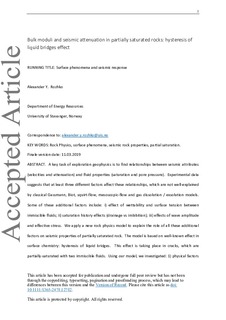| dc.contributor.author | Rozhko, Alexander | |
| dc.date.accessioned | 2019-03-26T14:42:11Z | |
| dc.date.available | 2019-03-26T14:42:11Z | |
| dc.date.created | 2019-03-20T16:21:20Z | |
| dc.date.issued | 2019-03-20 | |
| dc.identifier.citation | Rozhko, A.Y. (2019) Bulk moduli and seismic attenuation in partially saturated rocks: hysteresis of liquid bridges effect. Geophysical Prospecting, https://doi.org/10.1111/1365-2478.12782 | nb_NO |
| dc.identifier.issn | 0016-8025 | |
| dc.identifier.uri | http://hdl.handle.net/11250/2591866 | |
| dc.description | This is the peer reviewed version of the following article: Rozhko, A.Y. (2019) Bulk moduli and seismic attenuation in partially saturated rocks: hysteresis of liquid bridges effect. Geophysical Prospecting, which has been published in final form at https://onlinelibrary.wiley.com/doi/abs/10.1111/1365-2478.12782. This article may be used for non-commercial purposes in accordance with Wiley Terms and Conditions for Use of Self-Archived Versions. | nb_NO |
| dc.description.abstract | A key task of exploration geophysics is to find relationships between seismic attributes (velocities and attenuation) and fluid properties (saturation and pore pressure). Experimental data suggests that at least three different factors affect these relationships, which are not well‐explained by classical Gassmann, Biot, squirt‐flow, mesoscopic‐flow and gas dissolution/exsolution models. Some of these additional factors include: i) effect of wettability and surface tension between immiscible fluids; ii) saturation history effects (drainage vs imbibition); iii) effects of wave amplitude and effective stress. We apply a new rock physics model to explain the role of all these additional factors on seismic properties of partially saturated rock. The model is based on well‐known effect in surface chemistry: hysteresis of liquid bridges. This effect is taking place in cracks, which are partially‐saturated with two immiscible fluids. Using our model, we investigated: 1) physical factors affecting empirical Brie correlation for effective bulk modulus of fluid; 2) the role of liquids on seismic attenuation in the low frequency (static) limit; 3) water‐weakening effects and 4) saturation history effects. Our model is applicable in the low frequency limit (seismic frequencies) when capillary forces dominate over viscous forces during wave‐induced two‐phase fluid‐flow. The model is relevant for seismic characterization of immiscible fluids with high contrast in compressibilities, i.e. for shallow gas exploration and CO2 monitoring. | nb_NO |
| dc.language.iso | eng | nb_NO |
| dc.publisher | John Wiley & Sons Ltd. | nb_NO |
| dc.subject | rock physics | nb_NO |
| dc.subject | surface phenomena | nb_NO |
| dc.subject | seismic rock properties | nb_NO |
| dc.subject | partial saturation | nb_NO |
| dc.title | Bulk moduli and seismic attenuation in partially saturated rocks: hysteresis of liquid bridges effect | nb_NO |
| dc.type | Journal article | nb_NO |
| dc.type | Peer reviewed | nb_NO |
| dc.description.version | acceptedVersion | nb_NO |
| dc.rights.holder | © John Wiley & Sons Ltd. | nb_NO |
| dc.subject.nsi | VDP::Technology: 500::Rock and petroleum disciplines: 510::Petroleum engineering: 512 | nb_NO |
| dc.source.journal | Geophysical Prospecting | nb_NO |
| dc.identifier.doi | 10.1111/1365-2478.12782 | |
| dc.identifier.cristin | 1686460 | |
| cristin.unitcode | 217,8,11,0 | |
| cristin.unitname | Institutt for energiressurser | |
| cristin.ispublished | false | |
| cristin.fulltext | preprint | |
| cristin.qualitycode | 1 | |
